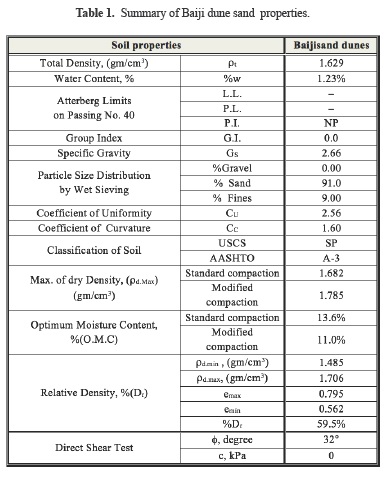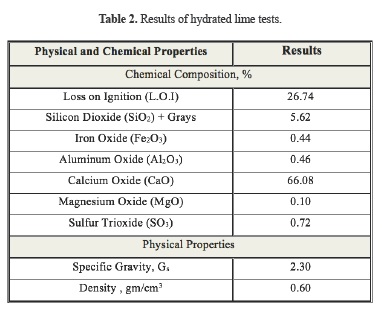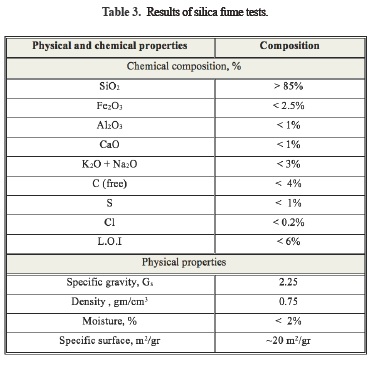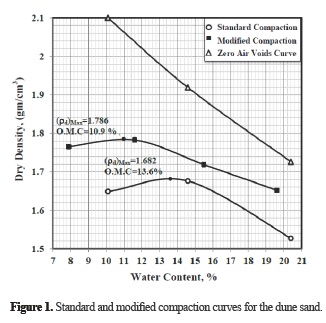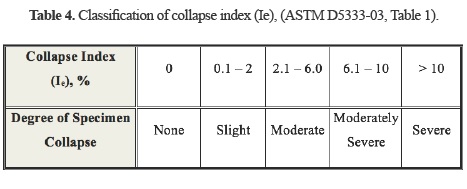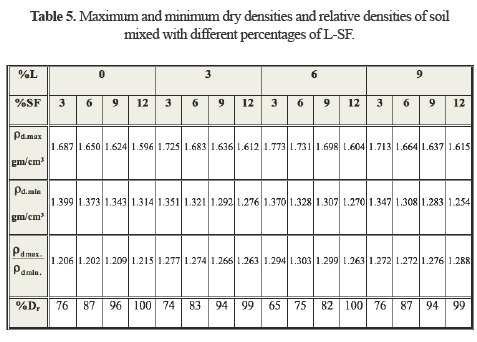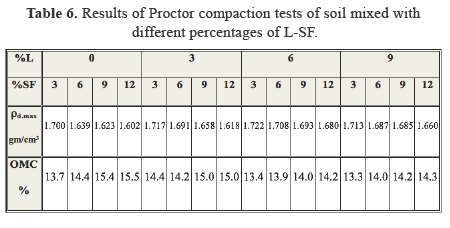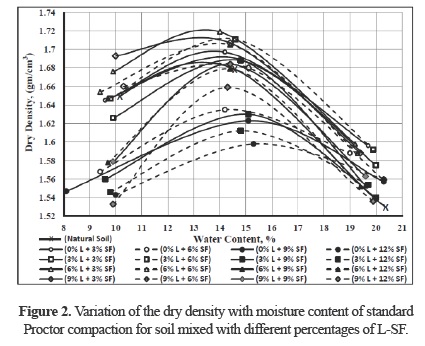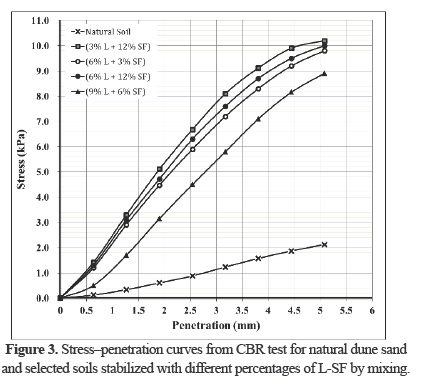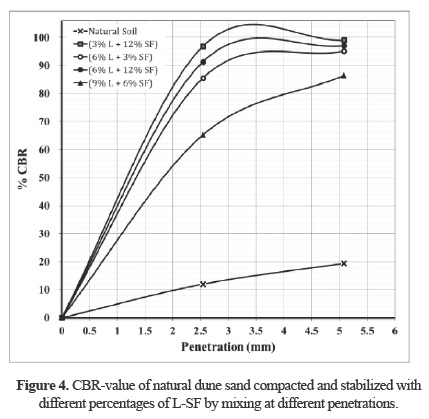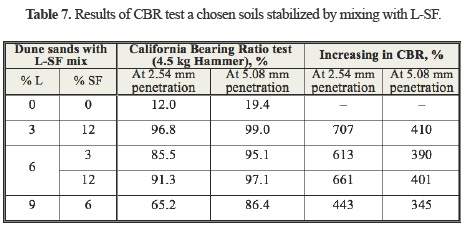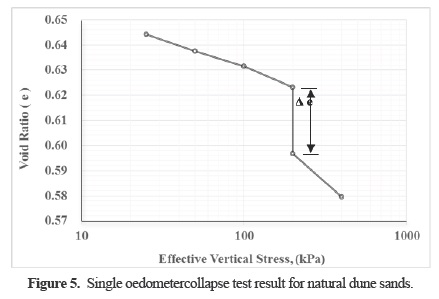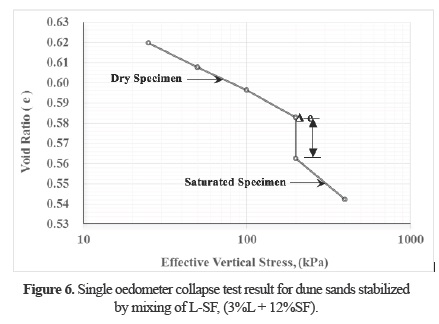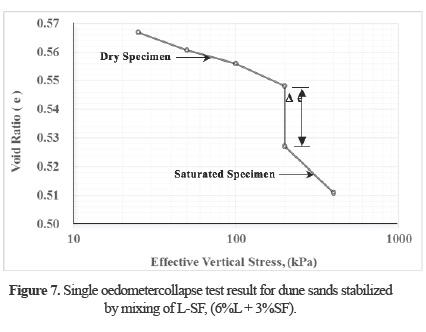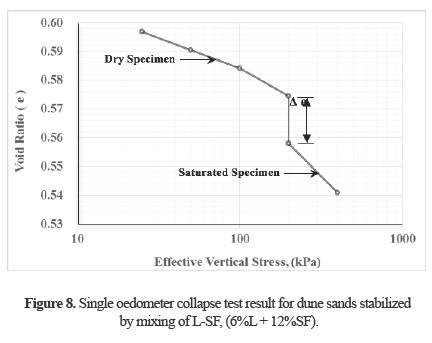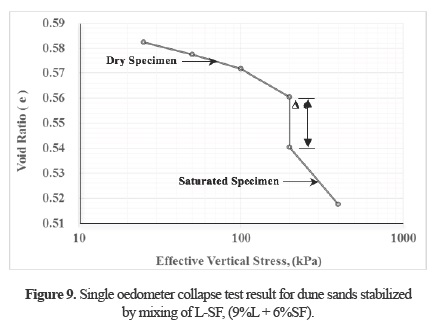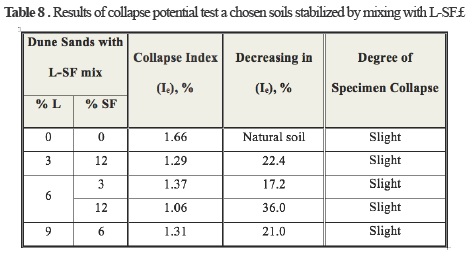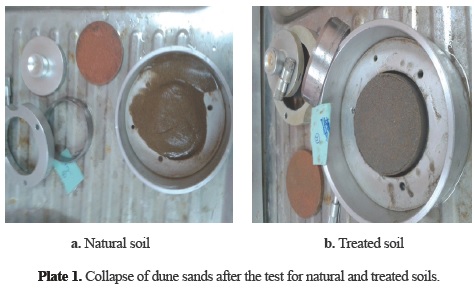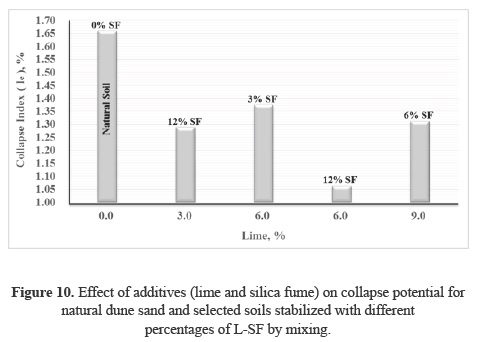Services on Demand
Journal
Article
Indicators
-
 Cited by SciELO
Cited by SciELO -
 Access statistics
Access statistics
Related links
-
 Cited by Google
Cited by Google -
 Similars in
SciELO
Similars in
SciELO -
 Similars in Google
Similars in Google
Share
Earth Sciences Research Journal
Print version ISSN 1794-6190
Earth Sci. Res. J. vol.20 no.2 Bogotá Apr./June 2016
https://doi.org/10.15446/esrj.v20n2.50724
Doi: http://dx.doi.org/10.15446/esrj.v20n2.50724
Compaction and Collapse Characteristics of Dune Sand Stabilized with Lime-Silica Fume Mix
Características de compactación y de colapso de arena de dunas estabilizada con una mezcla de óxido de calcio y óxido de silicio
Mohammed Y. Fattah1 Hasan H. Joni2 and Ahmed S. A. Al-Dulaimy3
1 Professor, Building and Construction Engineering Department, University of Technology, Baghdad, Iraq.
2 Assistant Professor, Building and Construction Engineering Department, University of Technology, Baghdad, Iraq.
3 Formerly graduate student, Building and Construction Engineering Department, University of Technology, Baghdad, Iraq.
Email: myf_1968@yahoo.com
Record
Manuscript received: 20/05/2015 Accepted for publication:13/05/2016
How to cite item
Fattah, M. Y., Joni, H. H., & Al-Dulaimy, A. S. A. (2016). Compaction and Collapse Characteristics of Dune Sand Stabilized with Lime-Silica Fume Mix. Earth Sciences Research Journal, 20(2), 11-18. doi: http://dx.doi.org/10.15446/esrj.v20n2.50724
ABSTRACT
The purpose of this research is to assess the suitability of dune sands as construction materials, moreover, such a purpose is considered beneficial in assessing appropriate methods for soil stabilization or ground improvement and to assess the suitability of dune sands as subgrade layer for carrying roads and rail foundation. Dune sand samples were collected from a region in Baiji area in Salah-Aldeen governorate, North of Iraq. A grey-colored densified silica fume (SF) and lime (L) are used. Three percentages are used for lime (3%, 6% and 9%) and four percentages are used for silica fume (3%, 6%, 9% and 12%) and the optimum percentage of silica fume is mixed with the percentages of lime. Unsoaked CBR on compacted dune sands treated dune sands with L-SF by mixing and cured for a period of 1 day. The increasing in CBR ranged between 443 – 707% at 2.54 mm penetration and 345 – 410% at 5.08 mm penetration.
Keywords: Dune sand, lime, silica fume, stabilization, CBR, strength.
RESUMEN
El propósito de esta investigación es evaluar el uso de arena de dunas como materiales de construcción. Además, este objetivo permite determinar los métodos apropiados para la estabilización del suelo, el mejoramiento del terreno y la evaluación de pertinencia de la arena de dunas en capas subbase para carreteras y cimientos férreos. Se recolectaron muestras de arena de dunas en el área de Baiji, del comisionado Salah-Aldeen, al norte de Irak. Se utilizó vapor de óxido de silicio (SF, en inglés), grisáceo y densificado, y óxido de calcio (L). Se utilizaron tres porcentajes para el óxido de calcio (3 %, 6 % y 9 %), y cuatro para el óxido de silicio (3 %, 6 %, 9% y 12%) y el máximo porcentaje del óxido de silicio se mezcló con las proporciones de óxido de calcio. Se realizó en seco el Ensayo de Relación de Soporte de California (del inglés California Bearing Ratio, CBR) en arena de dunas compactada y tratada con la mezcla L-SF curada durante un día. El incremento en el ensayo CBR osciló entre 443-707 % en la penetración de 2.5 mm y 345-410 % en la penetración de 5.08 mm.
Palabras clave: Arena de dunas, óxido de silicio, óxido de calcio, estabilización, Ensayo de Relación de Soporte de California.
Introduction
Ground improvement refers to any procedure undertaken to increase the shear strength, decrease the permeability and compressibility, or otherwise render the physical properties of soil more suitable for projected engineering use. The improvement may be accomplished by drainage, compaction, preloading, reinforcement, and grouting, electrical, chemical or thermal methods. Among the various soil stabilization procedures, the most suitable one is selected depending upon the type of soil available, time, cost involved etc. (Kumar, 2010).
One of the most dramatic depositional landforms, which occupy large areas all over the world, is sand dune. Sand dunes in various forms cover large areas of the world. Extensive efforts have been made to understand their origin (Shearzid, 1989) physical and mineralogical properties, environmental impacts. Some studies have also been directed towards dune sand stabilization (Al-Soud, 2000). There is, however, scarcity in the literature concerning the geotechnical characteristics of these soils.
A single dune can be defined as a mound or hill of sand, which rises to a single summit. They are accumulations of windblown sand, which change their position or their shape due to wind action as long as their surface consists of loose granular material of appropriate size.
Some of typical properties of sand dunes are as follows (Das, 2007):
1. Grain size distribution of the sands at any particular location is uniform. The uniformity can be attributed to the sorting action of the winds.
2. The general grain size percentages decrease with distance from the source, because the wind carries the small particles farther than the large ones.
3. The relative density of sand deposited on the windward side of the dunes is as high as (50-65) % and decreases to about (0-15) % on the leeward.
Collapse is a typical feature of unsaturated, loose and low plasticity soils, which are typical features of dune sand. The behavior of collapsible soil is often quantified by conducting a Collapse Potential Test. However, these test interpret the soil behavior in terms of total stress, while it is well known that the behavior of soil is governed by its effective stress. Also the collapse is defined as the significant volume reduction observed when wetting an unsaturated sample under load. The collapsing behavior of this type of soil generally occurs when the water is introduced into the soil.
Collapsing cause damage too many civil engineering structures such as: spread footing, buildings, roads, highways, and earth dams leading to high economic losses. There are many factors affecting collapse behavior of compacted and soils which are: initial dry unit weight, initial water content, percentage of fines, and the method used in compaction, (Al-Juari, 2009).
To measure the collapsing potential of this type of soil, it may use an oedometer/consolidation ring to prepare an undisturbed sample (similar preparation as consolidation test). When water is introduced to this specimen, the sample may start to collapse, ie. change in height(dh/h) or change in initial void ratio (e/eo) may be used as the degree of collapse of the soil.
Janning and Knight discussed the problem in 1957. Then, in 1963, they proposed a test method by which they determined the collapse potential for one specimen under an applied vertical stress of 200kPa, after one day of soaking, (Albusoda and Salem, 2012 and Mansour et al., 2008).
Abbeche et al., 2010 have studied the soil collapse and listed the factors contributing to the occurrence of this phenomenon. The main factors are summarized as follows:
1. An open unstable structure and partially saturated.
2. A high total stress is applied.
3. The presences of cementing agent in the soil, for example calcium carbonate (CaCO3), in unsaturated conditions contribute to stabilize the soil. A moistening the soil will reduce the suction and destroy the liaison officer.Albusoda and Salem (2012) used cement kiln dust (CKD) to stabilize Affek dune sand The effectiveness of adding different percentages of (CKD) was studied. Time of curing effect, was also considered. It was found that stabilization of collapsible soils with CKD can provide tremendous advantages. ading of 8% CKD, for example, increased the ultimate bearing capacity of shallow foundation to 250%. The variation in shear strength parameters became almost constant after fourteen days of curing.
Vegetation cover on sand dunes mainly depends on wind power (drift potential—DP) and precipitation. When this cover decreases below a minimal percentage, dunes will start moving. It is therefore necessary to study the effects of DP and precipitation on contemporary dune activity in order to predict likely future dune mobility in the coming decades. Ashkenazy et al. (2012) concentrated on the future activity of the currently fixed dune fields of the Kalahari and the Australian deserts. These sand seas include the largest areas of stabilized dunes in the world, and changes in their mobility have significant economic implications. Global maps of DP are introduced, based on real and reanalysis data. Analyses of two global circulation models (GFDL and CGCM3.1) provide future predictions under the SRES-A1B IPCC scenario, which is a moderate global warming scenario. According to the GFDL model, both the Australian and Kalahari basin dunes will apparently remain stable towards the end of the 21st century because the DP will stay small, while the rate of precipitation was expected to remain much above the minimal threshold necessary for the vegetative growth that leads to dune stabilization. The CGCM model predicts insignificant changes in DPs and shows that the precipitation rate is above 500 mm/year for almost the entire Kalahari basin. The central-northern part of Australia is predicted to have larger DPs and greater precipitation than the southern part. Since the predicted changes in DP and precipitation are generally not drastic, both the Australian desert and Kalahari basin dunes are not likely to become active. Still, the Australian dunes are more likely to remobilize than the Kalahari ones due to some decrease in precipitation and an increase in wind power.
The research work carried out by Bouziani et al. (2012) dealt with the effect of dune sand, available in huge quantities in these regions, on the properties of flowing sand-concrete (FSC) prepared with different proportions of dune and river sands. Mini-cone slump test, v-funnel flow-time test and viscosity measurements were used to characterize the behaviour of FSC in fresh state. The 28-day compressive strength was also determined. Test results showed that an optimal content of dune sand, which makes satisfied fresh and hardened properties of FSC, is obtained. Moreover, the obtained flow index (constant b) calculated by the help of power-law viscosity model is successfully correlated to the experimental results of v-funnel flow time.
Jackson et al. (2014) stated that seven types of coastal dune are identified on KwaZulu-Natal coast: estuary barrier dunes; mainland beach foredunes; prograded beachridge dunes; headland bypass dunes; transverse dune fields; parabolic/migrating dunefield; and climbing dunes. The development and distribution of the various dune forms is more strongly controlled by the geological setting, than the aerodynamic regime.
Ciccarelli (2014) tried to assess the conservation status of coastal dune systems in Tuscany (Italy). Emphasis was given to the presence and abundance of plant communities identified as habitat in accordance with the Directive 92/43/EEC. Twenty transects perpendicular to the shoreline were randomly positioned on the whole coastal area (30 km in length) in order to sample the full spectrum of plant communities. Vegetation zonation and relationships with the most frequent disturbance factors in the study area—beach cleaning, coastline erosion, presence of paths and roads, bathing settlements and trampling—were investigated through principal coordinate analysis and canonical correspondence analysis. Natural factors, such as distance from the sea and total length, were also considered. Differences in the conservation status of the sites were found, ranging from the total disappearance of the foredune habitats to the presence of the complete psammophilous (sand-loving) plant communities. Erosion, trampling, and paths were found to be closely correlated with degradation and habitat loss. Furthermore, the overall plant species diversity of dunes was measured with NHDune, a modified version of the Shannon index; while the incidence of invasive taxa was calculated using N, a naturalness index. However, these diversity indices proved to be a weaker bioindicator of ecosystem integrity than habitat composition along transects. A possible strategy for the conservation and management of these coastal areas could be to protect the foredunes from erosion and limit trampling through the installation of footbridges or the use of appropriate fences.
The purpose of this research is to assess the suitability of dune sands as construction materials. The tests include field density, moisture content, classification, compaction, relative density and CBR test. The effectiveness of adding different percentages of lime-silica fume mix was studied.
Experimental Work:
Dune sand samples were obtained from Baiji area in Salah-Aldeen governorate – North of Iraq. Three disturbed samples were taken from the surface at a depth of 0.4 m. The consistency and other physical properties of the dune sand were studied by a series of tests. Lime-silica fume mix is suggested to overcome the problems of dune sands. The physical and chemical properties of these materials are determined. The specification of each material is as follows:
In situ field density (rfield) was obtained by sand-cone test according to (ASTM D 1556-00). The moisture content (%w.c) for the soil studied was determined according to (ASTM D 2216-00).
Grain size distribution was determined by sieve analysis and hydrometer tests conducted on dune sands samples in accordance with (ASTM D 422-00). The grain size distribution of the soil used reveals that the soil is composed of 91% sand, 3% silt and 6% clay.
Table 1 summarizes the physical properties of dune sand.
The minimum and maximum dry densities, rd.min and rd.max, were determined according to (ASTM D 4254-00) and (ASTM D 4253-00), respectively.
The lime material (L):
Calcium hydroxide (slaked lime) is most widely used for stabilization. Calcium oxide (Hydrated lime) may be more effective in some cases. Chemical and physical tests were carried on the lime material in the National Center for Construction Laboratories and Research (NCCLR) in Iraq. The results of chemical and physical properties of the lime used are shown in Table 2.
Silica fume material (SF):
A grey-colored densified silica fume is used. It is a pozzolanic material which has a high content of amorphous silicon dioxide and consists of very fine spherical particles. Silica fume was used as an additive material to improve soil properties. The presence of this substance gives greatly improved internal cohesion, water retention and increased density when set. Chemical and physical tests were carried on the silica fume material in the National Center for Construction Laboratories and Research (NCCLR) in Iraq. The results of the chemical analysis of this material are presented in Table 3.
Compaction test:
Moisture-density relationship was determined by means of the standard and modified Proctor compaction test. The tests were performed in accordance with (ASTM D 698-00, method A) and (ASTM D 1557-00, method A) standards, respectively. The moisture density relationships are shown in Figure 1.
California Bearing Ratio (CBR) test:
CBR-value is used as an index of soil strength and bearing capacity. A series of tests were conducted on each dune sand sample as unsoaked samples. The preparation of specimens and testing procedure were generally in accordance with ASTM D 1883-99 and ASTM D 1557-00. The specimens were prepared at 95% of maximum dry density of the modified compaction test, and compacted in five layers using 4.5 kg hammer dropped from a height of 45 cm. Fifty six blows per layer were used for compacting the two specimens.
California Bearing Ratio values were determined and calculated as follows (ASTM D 1883-99):
CBR value was measured after 1 day curing for the soil stabilized with L-SF. The test was performed on samples prepared at 95% of optimum moisture content and compacted to various densities.
Collapse Test:
Collapse test of soil the soil studied was determined according to (ASTM-D5333-03). The magnitude of one-dimensional collapse that occurs when the soil inundated with water.
The test method consists of placing a compacted soil specimen at the desired water content in an oedometer, applying a predetermined applied vertical stress to the specimen and inundating the specimen with distilled deionized water to induce the potential collapse in the soil specimen. The test method follows these steps.
The one-dimensional response-to-wetting test, which is performed using conventional consolidation equipment represents the frequently used laboratory collapse test for determining the collapse potential of the soil. Pressure was applied until the stress on the sample was equal to (or greater than) that expected in the field or up to 200 kPa as suggested by Jennings and Knight (1975) and as standardized by ASTM D-5333 (2003). According to ASTM D5333 (2003), collapse: indicates a decrease in the height of confined soil following wetting at a constant applied vertical stress.
A standard oedometer ring of 75 mm diameter specimen was prepared in steel ring. After careful placing. The effective vertical stresses used were: (25, 50, 100, 200 and 400) kPa.
The collapse potential (Ic) denotes the percent-relative magnitude of collapse determined at any stress level as follows (ASTM D-5333-03):
where: Δh= the change in specimen height resulting from wetting, mm, and ho= the initial specimen height, mm.
Equation (2) may be rewritten in terms of void ratio as follows:
where: eB, e1= the void ratio at the appropriate stress level before wetting, eI , e2 = the void ratio at the appropriate stress level after wetting, and eo= the initial void ratio.
The collapse index (Ie), which is the wetting induced strain measured at a reference stress level of 200 kPa. The classification of collapse index is listed in Table 4, (ASTM D5333-03).
Results and Discussion
Table 5 shows the maximum density, minimum density and relative density values of the soil mixed with different percentages of lime-silica fume mix. The table shows the increase in relative density of soil with increasing of L-SF content due to the low values of the density of lime (0.60 gm/cm3) and silica fume (0.75 gm/cm3). This indicates that the additives (lime and silica fume) are fine materials and these materials relatively filled the voids of dune sands about on executing maximum density test (ASTM D 4253), which led to the increase in maximum density for soil and thereby increase the relative density. This difference may be attributed to the round - shape of sand particles tested, (Lambe and Whitmen, 1979).
Results of compaction test:
Table 6 and Figure 2 show the moisture-dry density relationship for stabilized soil. By examining the results, the following points could be noticed:
1. For small percentage of silica fume, (3%) and any percentage of lime, there is a decrease in the optimum water content with slight increase in maximum dry density.
2. The soils stabilized with (6%, 9% and 12%) of silica fume and any percentage of lime (which are fine materials) were compacted at lower maximum dry density and higher optimum water content. The increase in optimum moisture content due to addition of lime and silica fume may be caused by the absorption of water by L-SF mix.
3. The percentage (6% L + 3% SF) revealed the maximum dry density.
4. The shape of curves became more flat with increase of the L-SF percentage. Similar finding was reported by Parsons et al., (2004) and Al-Jobouri, (2013).
Results of California bearing ratio (CBR) tests:
The values of stresses are plotted against depth of penetration in Figure 3. Stress and penetration curves for Baiji dune sands consist of an approximately straight portion for about 3 mm penetration in which stress and penetration are directly proportional, then tend to become a horizontal at further penetration.
Unsoaked CBR values at 2.54 and 5.08 mm penetration are plotted in Figure 4 and summarized in Table 7. The higher CBR values are obtained at 5.08 mm penetration for Baiji dune sands, where the soil is sand and containing lower percentage of material passing the No. 200 sieve.
The results of Figure 4 show that when stabilizing the soil with L-SF after curing for 1 day, there is an increase in CBR due to the increase in the angle of internal friction (f) or cohesion (c) or both. The added materials of L-SF play the major role in stabilization. Using this type of material is reflected in the improvements in terms of bearing capacity which is directly proportional to CBR.
CBR-value increase with increasing silica fume but this increasing reduces with increasing lime. The increase in CBR ranged between (443–707)% at 2.54 mm penetration and (345–410) % at 5.08 mm penetration as illustrated in Table 7 and this increase is calculated as follows:
Results of Collapse Test:
Single oedometer test is selected for the collapse test for disturbed and undisturbed samples. This test is carried out according to the procedure recommended by ASTM D5333.
Collapse potential (Ic) and collapse index (Ie) magnitude are determined according ASTM D5333-03 by using the conventional oedometer device in a constant temperature and humidity environmental at different stress level. It shows high values when flooding the specimens by water during primary consolidation. It is concluded that there is an increases in collapsibility due to removal of bonding between particles upon wetting due to stress release and leaching of soil during water infiltration leading to softening due to rearrangement of soil particles. Moreover, the collapse potential decreases with the increase in the relative density. This is due to the reduction in void ratio of the specimens with increasing the relative density.
Figures 5 to 9 and Table 8 show the collapse potential decreases slightly with increasing the percentage of L-SF mix for soil samples tested by single collapse. The collapse index and potential of treated soil are found less than that of natural soil and decrease with increasing stabilizer content. Collapsing increased continuously with applied stresses. On the other hand, the added silica content to the treated soil has an effect of higher than lime in reducing the collapse index at different stresses. Plate 1 shows the collapse of natural and treated dune sands after test.
The decreasing in collapse index ranged between (17.2–36)% at 200 kPa as illustrated in Table 8 and this decrease is calculated as follows:
The calculated collapse index (Ie)gives an indication thatdegree of specimen collapse for soil. Baiji dune sands undergo only small collapse. The degree of collapse of this natural soil is classified as “Slight” under different soaking pressure. This result coincides with the results found by (Al-Taieet al., 2013). Also degree of collapse for treated soils by mixing with L-SF mix are classified as “Slight” as shown in Table 8.
Figure 10 gives the collapse percent versus percent of lime and silica fume, diagrams obtained from one dimensional consolidation. It is clear that there is a slightly decrease in collapse with increasing stabilizers content. L-SF is effective in reducing the collapse potential of the soil. On the other hand, add L-SF decrease void ratio of soil. This indicates that the additives (lime and silica fume) are fine materials and these materials relatively filled he voids of dune sands about on executing compaction, which led to the increase in relative density for soil and thereby decrease the collapse index.
Conclusions:
1. The mix of L-SF allowed compaction of the soil at higher maximum dry density. The treatment with L-SF shows a general increase in the maximum dry density from (1.609 to 1.722) gm/cm3 of standard compaction, and from (1.609 to 1.834) gm/cm3 of modified compaction at (6% L + 3% SF).
2. The optimum water content increases from 13.6% to 15.5% at 12% SF of standard compaction, the increase in the optimum moisture content is due, in spite of the reduced surface area caused by flocculation and agglomeration, to the additional fine contents to the samples which requires more water in addition to the free lime and silica fume that needed more water for the pozzolanic reactions to take place.
3. Unsoaked CBR on compacted dune sands treated with L-SF by mixing and cured for a period of 1 day, exhibited higher CBR values than compacted untreated dune sands. Moreover, the 5.08 mm penetration CBR of the treated dune sands is higher than the 2.54 mm penetration CBR. The increasing in CBR ranged between 443 – 707% at 2.54 mm penetration and 345 – 410% at 5.08 mm penetration.
4. The degree of collapse of natural Baiji dune sands and treated soils by mixing with L-SF mix are classified as “Slight” under different soaking pressure.
5. The difference in collapse potential between some percent of L-SF becomes very little. This means that any additional amount of L-SF does not improve considerably the control of collapse. Collapse potential and collapse index decreased with stabilizers content and drop to (Ie= 1.06%) at (6%L + 12%SF). Finally, L-SF treatment in dune sands generally reduces collapse. The decreasing in collapse index ranged between (17.2–36)% at 200 kPa for treated soils.
References:
Abbech, E. K., Laouar, M. S., & Messaoud, F. (2010). Prediction of collapsible soils by cone penetrometer and ultra-sonic tests. Studia Geotechnica et Mechanica, vol. XXXII, no. 2. [ Links ]
Albusoda, B. S. & Salem, L. A. (2012). Stabilization of dune sand by using cement kiln dust (CKD). Journal of Earth Sciences and Geotechnical Engineering, 2(1), 131-143. [ Links ]
Al-Jobouri M. M. (2013). Strength and compressibility characteristics of soft soil stabilized with lime silica fume mix. M.Sc. thesis, Civil Engineering Department, University of Baghdad, Iraq. [ Links ]
Al-JuariKh A. (2009). Volume change measurement of collapsible soil stabilized with lime and waste lime. Civil Engineering, Tikrit Journal of Engineering Sciences, 16(3), 38-54. [ Links ]
Al-Soud, M. S. (2000). Stabilization of Baiji sand dunes by petroleum residues. M.Sc. thesis, Civil Engineering Department, University of Baghdad, Iraq. [ Links ]
Al-Taie, A. J., Al-Shakarchi, Y. J., & Mohammed, A. A. (2013). Investigation of geotechnical specifications of sand dune soil. A case study around Baiji Iraq. Civil Engineering, International Journal of Advanced Research, 1(6), 208-215. [ Links ]
Ashkenazy, Y., Yizhaq, H., & Tsoar, H. (2012). Sand dune mobility under climate change in the Kalahari and Australian deserts. Climatic Change, 112, 901-923, DOI: 10.1007/s10584-011-0264-9. [ Links ]
ASTM D1883-99 (1999). Standard test methods for CBR (California Bearing Ratio) of laboratory-compacted soils. American Society for Testing and Materials. [ Links ]
ASTM D5333-03 (2003). Standard test methods for measurement of collapse potential of soils. American Society for Testing and Materials. [ Links ]
Bouziani, T., Bederina, M., Hadjoudja, M. (2012). Effect of dune sand on the properties of flowing sand-concrete (FSC). International Journal of Concrete Structures and Materials, 6(1), 59-64. DOI 10.1007/s40069-012-0006-z. [ Links ]
Ciccarelli, D. (2014). Mediterranean coastal sand dune vegetation: influence of natural and anthropogenic factors. Environmental Management, 54, 194-204. DOI: 10.1007/s00267-014-0290-2. [ Links ]
Cooke, R. U., & Warren, A. (1973). Desert geomorphology. London: B. T. Batsford Ltd., 374 pp. 1st. Edition. [ Links ]
Das, B. M. (2007). Principles of foundation engineering. Adapted International Student Edition, Nelson a Division of Thomson Canada Limited. Sixth edition. [ Links ]
Jackson, D. W. T., Cooper, J. A. G., & Green, A. N. (2014). A preliminary classification of sand dunes of the KwaZulu-Natal coast. In: Green, A. N. & Cooper, J. A. G. (eds.), Proceedings 13th International Coastal Symposium (Durban, South Africa), Journal of Coastal Research, Special Issue 70, 9, pp. 718-722, ISSN 0749-0208. DOI: 10.2112/SI70-121.1. [ Links ]
Jannings, J. E., & Knight, K. (1975). A guide to truction on or with materials exhibiting additional settlement due to collapse of grain structure. Proceedings, sixth regional conference for Africa on soil mechanics and foundation engineering Johannesburg, South Affrica, pp. 99-105. [ Links ]
Kumar, S. (2010). A study on the engineering behaviour of grouted loose sandy soils. Ph.D. thesis, Division of Civil Engineering, Cochin University of Science and Technology, India, 2010. [ Links ]
Lambe, T. W. & Whitman, R. V. (1979). Soil mechanics. John Wiley and Sons Inc., New York. [ Links ]
Mansour, Z., Chik, Z., & Taha, M. R. (2008). On soil collapse potential evaluation. University Kebangsaan Malaysia, ICCBT 2008 -E- (03), pp. 21-32. [ Links ]
Parsons, R. L., Kneebone, E., & Milburn, J. P. (2004). Use of cement kiln dust for subgrade stabilization. Final Report, Kansas Department of Transportation, USA. [ Links ]
Shearzid, M. F. (1989). Sediment wind and its impact on the design of human settlements. M.Sc. thesis, Department of Architectural Engineering, University of Technology, Baghdad, Iraq. [ Links ]













